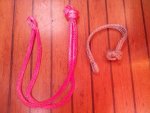MathiasW
Well-Known Member
Interesting - thanks.
What's your definition of an excellent snubber for an 8m by 4m cat?
As Jonathan suggested, it is the snubber stretch that differentiates an excellent snubber from a poor one. For the maths, I do not care how long the snubber is. That has no effect on its ability to store energy. It is by how much it can stretch with a given load. Of course, the stretch should be not too much compared to the overall length of the snubber, so as not to overload and break it.
Sorry for the brevity of initial post.


